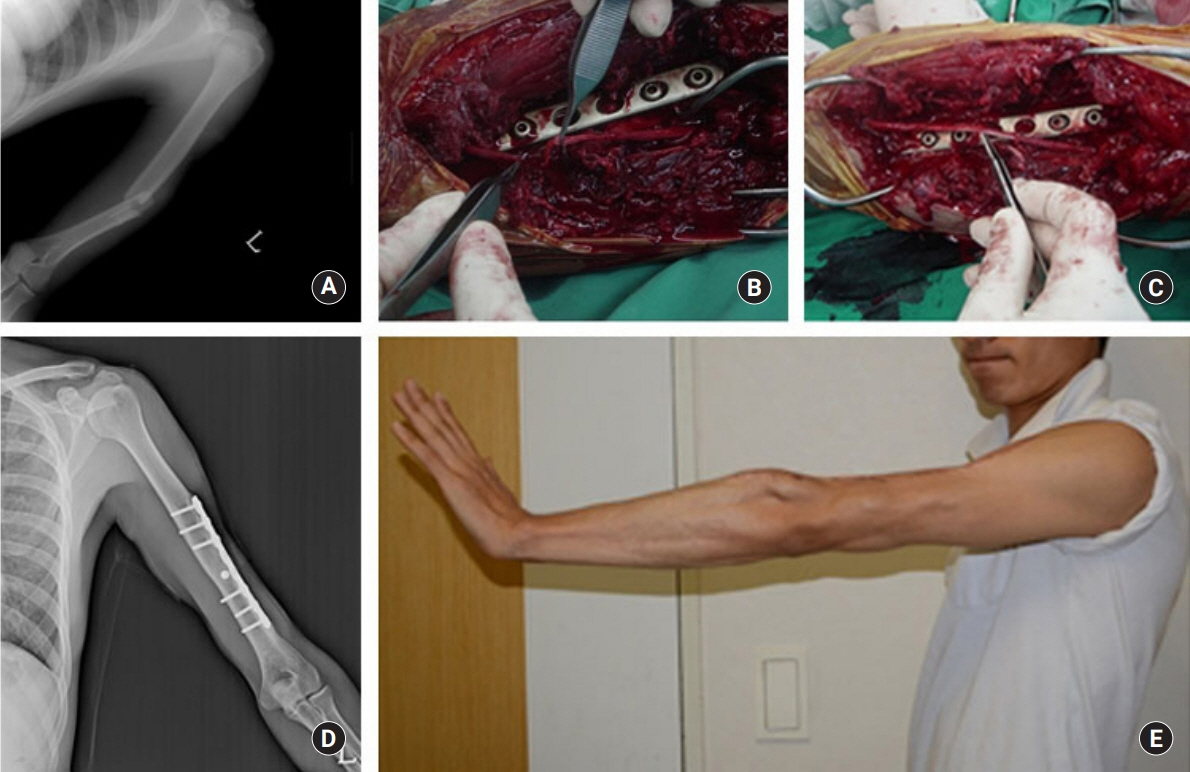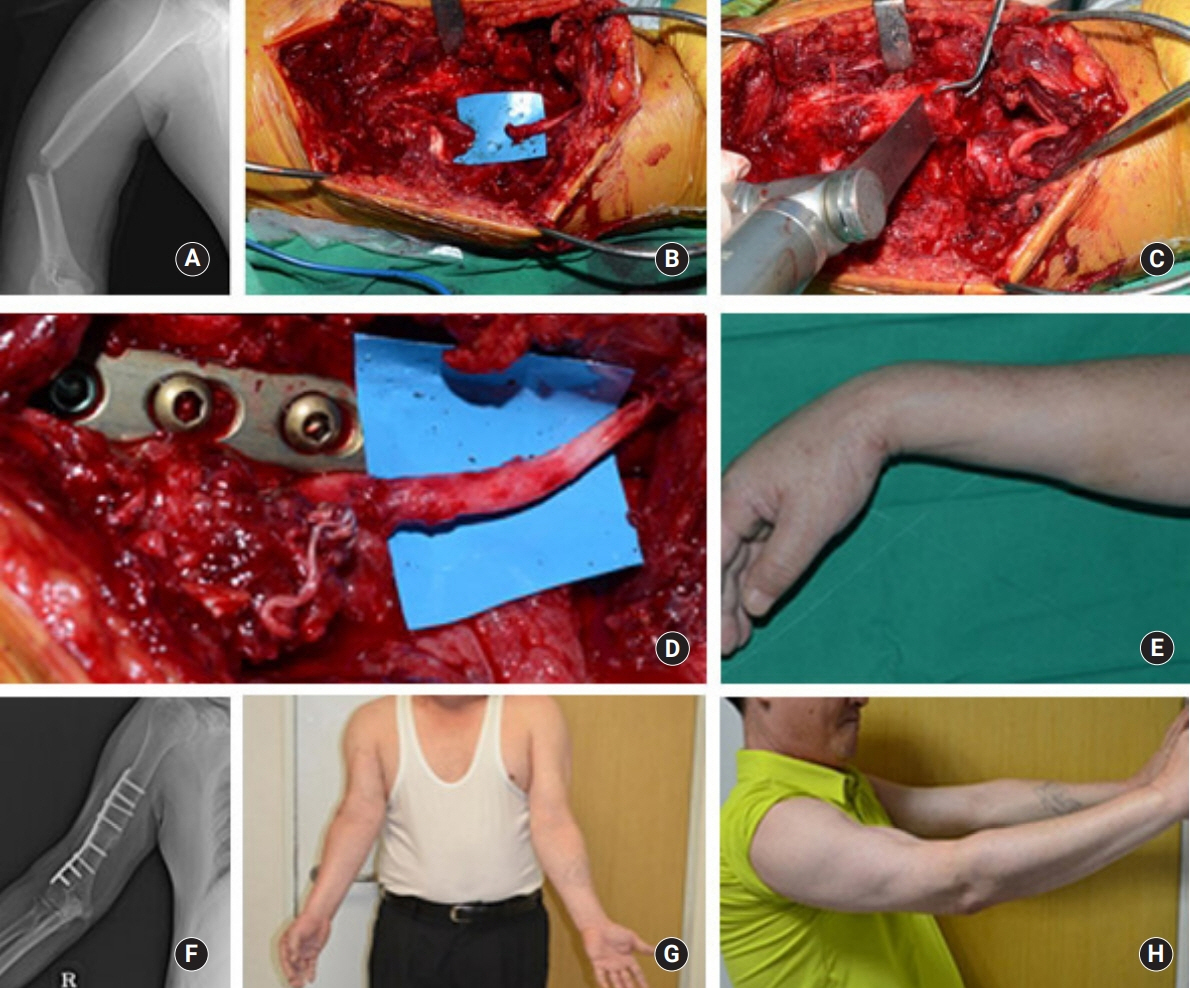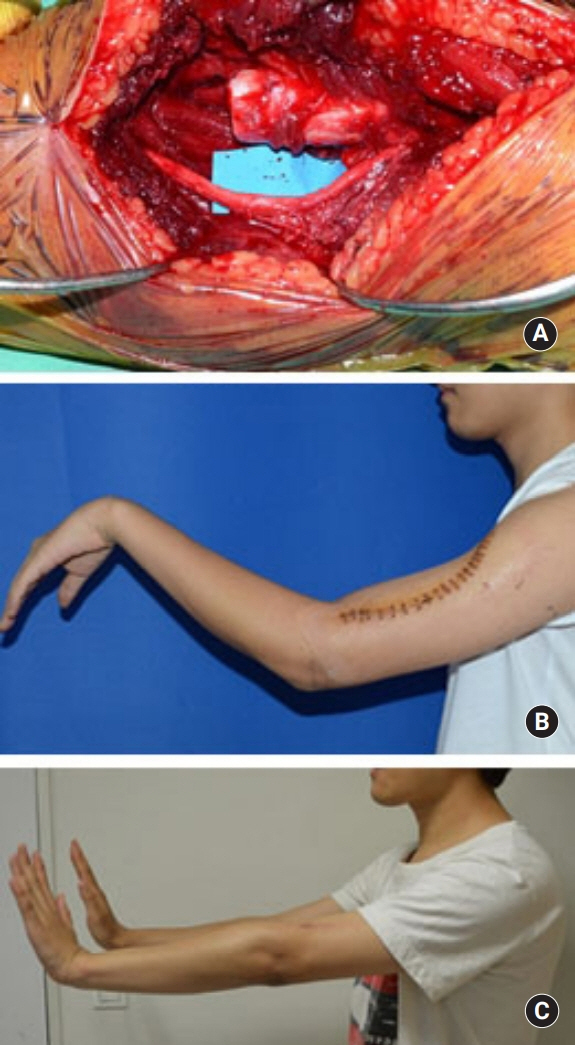Arch Hand Microsurg.
2020 Mar;25(1):60-66. 10.12790/ahm.19.0071.
Treatment of Radial Nerve Palsy Associated with Humeral Shaft Fracture
- Affiliations
-
- 1Department of Orthopedic Surgery, CHA Bundang Medical Center, CHA University, Seongnam, Korea
- KMID: 2501113
- DOI: http://doi.org/10.12790/ahm.19.0071
Abstract
- Radial nerve palsy associated with humeral shaft fracture is divided into primary paralysis immediately after injury and secondary paralysis after reduction or surgery. There are conflicting opinions about the timing and necessity of early neuro-exploration for patient with primary paralysis. The main cause of radial nerve injury is nerve contusion and it has high natural recovery rate without any treatment on nerves. However, if the nerve is damaged, early neuro-exploration is needed to increase the possibility of full recovery, prevent secondary nerve damage by the bone or scar tissue and predict prognosis. Through this, there is an advantage to plan future treatment. Based on the study of these patients, when internal fixation is indicated, early surgical exploration of the radial nerve should be considered to minimize poor prognosis and conflict with the patient.
Keyword
Figure
Reference
-
References
1. DeFranco MJ, Lawton JN. Radial nerve injuries associated with humeral fractures. J Hand Surg Am. 2006; 31:655–63.
Article2. Lowe JB 3rd, Sen SK, Mackinnon SE. Current approach to radial nerve paralysis. Plast Reconstr Surg. 2002; 110:1099–113.
Article3. Niver GE, Ilyas AM. Management of radial nerve palsy following fractures of the humerus. Orthop Clin North Am. 2013; 44:419–24.
Article4. Pollock FH, Drake D, Bovill EG, Day L, Trafton PG. Treatment of radial neuropathy associated with fractures of the humerus. J Bone Joint Surg Am. 1981; 63:239–43.
Article5. Shao YC, Harwood P, Grotz MR, Limb D, Giannoudis PV. Radial nerve palsy associated with fractures of the shaft of the humerus: a systematic review. J Bone Joint Surg Br. 2005; 87:1647–52.6. Ekholm R, Ponzer S, Tornkvist H, Adami J, Tidermark J. Primary radial nerve palsy in patients with acute humeral shaft fractures. J Orthop Trauma. 2008; 22:408–14.
Article7. Park TS, Lee JH, Kim TS, Lee KH, Park KC. Contributing factors of radial nerve palsy associated with humeral shaft fracture. J Korean Fract Soc. 2008; 21:292–6.
Article8. Gerwin M, Hotchkiss RN, Weiland AJ. Alternative operative exposures of the posterior aspect of the humeral diaphysis with reference to the radial nerve. J Bone Joint Surg Am. 1996; 78:1690–5.
Article9. Guse TR, Ostrum RF. The surgical anatomy of the radial nerve around the humerus. Clin Orthop Relat Res. 1995; (320):149–53.
Article10. Bostman O, Bakalim G, Vainionpaa S, Wilppula E, Patiala H, Rokkanen P. Radial palsy in shaft fracture of the humerus. Acta Orthop Scand. 1986; 57:316–9.11. Garcia A Jr, Maeck BH. Radial nerve injuries in fractures of the shaft of the humerus. Am J Surg. 1960; 99:625–7.
Article12. Kettelkamp DB, Alexander H. Clinical review of radial nerve injury. J Trauma. 1967; 7:424–32.
Article13. Lee SW, Cho CH, Bae KC. Associated factors of radial nerve palsy combined with humerus shaft fracture. J Korean Fract Soc. 2014; 27:185–90.
Article14. Han SH, Hong IT, Lee HJ, Lee SJ, Kim U, Kim DW. Primary exploration for radial nerve palsy associated with unstable closed humeral shaft fracture. Ulus Travma Acil Cerrahi Derg. 2017; 23:405–9.15. Klenerman L. Fractures of the shaft of the humerus. J Bone Joint Surg Br. 1966; 48:105–11.
Article16. Shaw JL, Sakellarides H. Radial-nerve paralysis associated with fractures of the humerus. A review of forty-five cases. J Bone Joint Surg Am. 1967; 49:899–902.17. Park MJ, Ryu BD. Prevention of the Radial Nerve Injury During Operation of the Humerus Shaft Fracture. J Korean Soc Surg Hand. 2004; 9:32–35.18. Bodner G, Huber B, Schwabegger A, Lutz M, Waldenberger P. Sonographic detection of radial nerve entrapment within a humerus fracture. J Ultrasound Med. 1999; 18:703–6.
Article19. Yoon HM, Kho DH, Kim HJ, Nam KM, Kang DM. Ultrasonography in radial nerve palsy after surgery of humerus shaft fracture-case report. J Korean Orthop Ultrasound Soc. 2012; 5:106–12.20. Noaman H, Khalifa AR, El-Deen MA, Shiha A. Early surgical exploration of radial nerve injury associated with fracture shaft humerus. Microsurgery. 2008; 28:635–42.
Article21. Ring D, Chin K, Jupiter JB. Radial nerve palsy associated with high-energy humeral shaft fractures. J Hand Surg Am. 2004; 29:144–7.
Article
- Full Text Links
- Actions
-
Cited
- CITED
-
- Close
- Share
- Similar articles
-
- Surgical Treatment of Old Radial Nerve Palsy Associated with Nonunion of Humeral Shaft Fractures
- Contributing Factors of Radial Nerve Palsy Associated with Humeral Shaft Fracture
- A Clinical Study of the Humeral shaft Fracture
- Internal Fixation of Humeral Shaft Fractures Using Anterior Plating Technique
- Associated Factors of Radial Nerve Palsy Combined with Humerus Shaft Fracture




